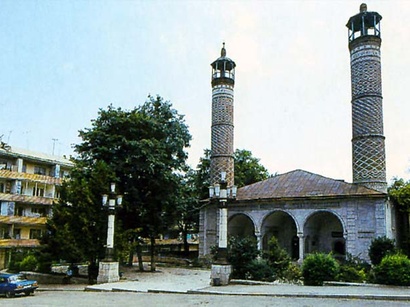Quarter-century passes since Shusha’s occupation

By Rashid Shirinov
May 8 marks the 25th anniversary of the occupation of Azerbaijan's ancient town of Shusha by Armenian invaders.
Shusha has always been one of unique cultural centers of Azerbaijan, distinguished for its natural and man-made beauty. The city played an important role both from economic- political and cultural point of view in the history of Azerbaiijan.
Ancient Shusha was founded by famous Azerbaijani Khan Panahali in the middle of the 18th century on the highest site of the Karabakh province. The city was also called Panahabad in honor of its founder, Khan.
This town, which went down in history thanks to such prominent figures as Gasim bey Zakir, Khurshidbanu Natavan, Mir Mohsun Navvab, Najaf bek Vezirov, Abdurrahim bey Hagverdiyev, Yusif Vazir Chemenzeminli, Firidun bey Kocharli, Ahmed bey Agaoglu and other eminent personalities, is known worldwide as the cradle of the Azerbaijani national folk music mugham.
Shusha was also distinguished for its fresh air and rich nature. The Turshsu summer pastures, the Shakilli, Isa, Yukhari Dashalti springs, and the well-known Jidir Duzu valley were extremely popular among travellers.
One of the symbols of the city was Khari Bulbul, a beautiful and unique flower which grows in the mountains of Shusha, and doesn't grow elsewhere in the world. The flower looks as if a nightingale is sitting on it.
Shusha, built in line with ancient and medieval town-planning traditions, was divided into neighborhoods. Every neighborhood had a mosque, a spring and a bath-house of its own. Streets had block-stone pavement. With its 129 architectural sites and 17 neighborhoods, Shusha was a busy town prior to its occupation by the Armenians.
For centuries, people lived in peace and harmony in Shusha, but the situation radically changed in 1992. On May 8, the heart of Karabakh- Shusha was seized by Armenian invaders.
The Armenian armed forces occupied Shusha with the aid of the Soviet 366th regiment, killing and disabling hundreds of innocent Azerbaijani civilians, expelling the entire population of the town, and destroying, burning down, and looting numerous cultural, religious and historical monuments.
The occupant forces killed 195 civilians, while 165 persons wounded and 58 were taken hostages.
The fall of Shusha came as the last stage of Armenia's military occupation of the Nagorno-Karabakh region - part of Azerbaijan's historical and internationally recognized territory.
In order to wipe off historical traces of Azerbaijanis in Shusha, Armenians have razed to the ground about 600 historical-architectural monuments in Shusha, including palace of Panahali khan, Cuma mosque, Mosque of Ashagi Govhar Aga, house of poetess Khurshud Banu Natavan, tomb of poet Molla Panah Vagif, plundered and ruined 7 kindergartens, 22 schools, music school, 8 culture centers, 22 clubs, 31 libraries, 2 cinemas, 8 museums, including Shusha history museum, State Karabakh history museum, branch of State Capet Museum and Museum of National applied art, tourist center, and destroyed an only factory in the Caucasus producing Oriental music instruments.
Armenians also damaged monuments of such historical personalities as Uzeyir Hajibeyli, author of the first opera in the Orient, Bulbul, who laid the foundation of Azerbaijani vocal profession, and poetess Natavan.
About 5000 exhibits from the Shusha history museum, around 1000 exhibits from State Karabakh history museum, Shusha branch of Azerbaijan State Carpentry Mueum, museums of Uzeyir Hajibeyli (more than 300 exhibits), of Bulbul (about 400 exhibits), of Mir Movsum Navvab (more than 100 exhibits) have been plundered.
The invaders took to Armenia valuable exhibits of Shusha museums, rare Karabakh carpets, samples of folk and fine arts, archaeological finds, documents and many other things. Today, these treasures of Azerbaijani culture and history are being presented to the world as samples of the “Armenian culture.”
Shusha's natural resources were also plundered by Armenians. After the occupation, the Armenians seized the town’s natural resources, such as facing stone, clay, construction stone, fresh underground waters and mineral waters, and used them for their own purposes.
The occupation of Shusha and of Azerbaijan’s region of Nagorno-Karabakh in general resulted in killings of 20,000 Azerbaijanis and displacement of over 1 million people from their homes.
Armenian continues occupation of 20 percent of Azerbaijan's territory, including Nagorno-Karabakh and seven surrounding regions. The aggressor country rejects to implement four UN Security Council resolutions on withdrawal of its armed forces from Azerbaijani lands.
---
Rashid Shirinov is AzerNews’ staff journalist, follow him on Twitter: @RashidShirinov
Follow us on Twitter @AzerNewsAz
Here we are to serve you with news right now. It does not cost much, but worth your attention.
Choose to support open, independent, quality journalism and subscribe on a monthly basis.
By subscribing to our online newspaper, you can have full digital access to all news, analysis, and much more.
You can also follow AzerNEWS on Twitter @AzerNewsAz or Facebook @AzerNewsNewspaper
Thank you!
